What Two People Were Known for Their Art and Military Design
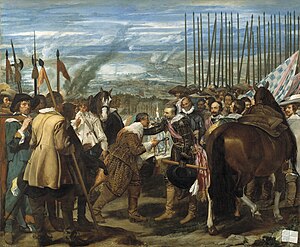

Military machine art is fine art with a military discipline matter, regardless of its mode or medium. The battle scene is ane of the oldest types of art in adult civilizations, every bit rulers have ever been keen to celebrate their victories and intimidate potential opponents. The delineation of other aspects of warfare, especially the suffering of casualties and civilians, has taken much longer to develop. Every bit well as portraits of military figures, depictions of anonymous soldiers away from the battlefield have been very common; since the introduction of armed forces uniforms such works frequently concentrate on showing the variety of these.
Naval scenes are very mutual, and battle scenes and "send portraits" are mostly considered as a co-operative of marine fine art; the development of other large types of military equipment such as warplanes and tanks has led to new types of work portraying these, either in activeness or at residuum. In 20th century wars official state of war artists were retained to draw the military in action; despite artists at present being very close to the action the boxing scene is by and large left to popular graphic media and the cinema. The term war fine art is sometimes used, mostly in relation to 20th century military art fabricated during wartime.[1]
History [edit]
Ancient globe [edit]

Fine art depicting military machine themes has existed throughout history.[two] The Battleground Palette, a cosmetic palette from the Protodynastic Period of Egypt (circa ~3500 to 3000 BC) is incomplete, but shows prisoners existence led abroad, and wild fauna feasting on the dead. The Narmer Palette from the aforementioned period shows a military victory in a more symbolic mode. The Stele of the Vultures, about ii,500 BC, is ane of a number of Mesopotamian "victory stelae". Also effectually 2,500 BC, the earliest known delineation of a city being besieged is institute in the tomb of Inti, an official from the 21st nome of Upper Egypt, who lived during the late Fifth Dynasty.[3] The scene shows Egyptian soldiers scaling the walls of a near eastern fortress on ladders.[four] Although the Battle of Kadesh in 1274 BC appears to have been inconclusive, reliefs erected by Ramesses Ii show him scattering his Hittite opponents with his chariot.
Surviving Assyrian art mainly consists of big stone reliefs showing detailed scenes of either military campaigns or hunting; the Lachish reliefs are an case of the former. The ancient Greek Parthenon Marbles show lengthy parades of the city's volunteer cavalry force, and many Greek vases show scenes of combat. In Han dynasty Prc, a famous rock relief of c. 150-170 Advertising from the Wu family shrines shows a battle betwixt cavalry forces in the Campaign against Dong Zhuo.[5]
In Ancient Roman art the well-nigh elaborate Roman triumphal columns showed very long reliefs of military campaigns winding round the body of huge columns; among the most impressive are those of Trajan and Marcus Aurelius in Rome. The Alexander Mosaic is a big and dramatic boxing scene showing Alexander the Bang-up defeating Darius III of Persia; it is a floor mosaic excavated from Pompeii, probably copying a lost painting.[6] Many Hellenistic and Roman sarcophagi showed crowded scenes of combat, sometimes mythological (an amazonomachy is a term for a scene of battle between Amazons and Greeks), and usually not relating to a item battle; these were not necessarily used to bury people with armed forces experience. Such scenes had a great influence on Renaissance battle scenes.[7] By the Late Roman Empire the reverse of coins very often showed soldiers and carried an inscription praising 'our boys', no doubt in hope of delaying the next military revolt.
Medieval [edit]

Christian art produced for the church mostly avoided battle scenes, although a rare Late Antique motif shows Christ dressed as a victorious emperor in general'due south dress, having conquered the devil, in Christ treading on the beasts and other iconographies. The fierce tastes of the Anglo-Saxon elite managed to add the Harrowing of Hell, conceived as a raid on Satan's stronghold, led by Christ, to the standard group of scenes for a cycle on the Life of Christ.[viii] Soldier saints, shown in military dress, were extremely popular, equally were images of the Archangel Michael stabbing Satan as a dragon with a cross with a spear-point at its base. Some illuminated manuscripts illustrated the many battles in the Old Attestation.
Secular works produced for secular patrons often show armed forces themes, for example in illuminated manuscript copies of histories like the 15th century Froissart of Louis of Gruuthuse (BnF Fr 2643-half-dozen), where nigh of the 112 miniatures show armed services scenes. The Siege of the Castle of Beloved, often institute on Gothic ivory mirror-cases, showed knights attacking a castle dedicated past ladies, a metaphor from the literature of courtly honey. The 11th century Bayeux Tapestry is a linear panoramic narrative of the events surrounding the Norman Conquest and the Boxing of Hastings in 1066,[ix] the but surviving instance of a type of embroidered hanging with which rich Anglo-Saxons used to decorate their homes. In Islamic art the boxing scene, often from a fictional piece of work of epic poetry, was a frequent subject in Farsi miniatures, and the high viewpoint they adopted made the scenes more than hands comprehensible than many Western images.
Renaissance to Napoleonic Wars [edit]
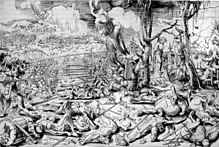
Italian Renaissance painting saw a great increase in war machine fine art by the leading artists, boxing paintings often featuring near-contemporary scenes such as the huge set of three canvases of The Battle of San Romano (c. 1445) by Paolo Uccello, and the abortive Battle of Cascina (1504–06) by Michelangelo and Boxing of Anghiari by Leonardo da Vinci (1503–06), which were intended to exist placed reverse each other in the Palazzo Vecchio in Florence, only neither of which were completed. For Renaissance artists with their new skills in depicting the human effigy, battle scenes allowed them to demonstrate all their skills in depicting complicated poses; Michelangelo cull a moment when a grouping of soldiers was surprised bathing, and almost all the figures are nude. Leonardo'due south boxing was a cavalry one, the central section of which was very widely seen before being destroyed, and hugely influential: it "exerted a fundamental alter on the whole idea of battle painting, an influence that lasted through the Belatedly Renaissance and the Baroque up until the heroic machines of the Napoleonic painters and even the battle compositions of Delacroix", according to the fine art historian Frederick Hartt.[10]
All of these depicted bluntly minor deportment where Florence had defeated neighbouring cities, merely important battles from distant history were every bit popular. Andrea Mantegna'south Triumphs of Caesar shows the Roman triumphal parade of Julius Caesar, though concentrating on the booty rather than the army post-obit it; the print series Triumphs of Maximilian shows both, leading upwards to Maximilian II, Holy Roman Emperor riding on a huge wagon. The Boxing of the Milvian Bridge by Giulio Romano brought a huge and "seminal" battle scene into the Raphael Rooms in the Vatican Palace.[7] The unusual The Battle of Alexander at Issus (1528–nine) by Albrecht Altdorfer managed to make one of the most highly regarded Renaissance battle scenes, despite, or perhaps considering of, having a vertical format, which was dictated by the planned setting; information technology was commissioned as one of a set up of eight battle paintings by various artists. "It was the almost detailed and panoramic battle moving-picture show of its twenty-four hour period",[six] and its aerial viewpoint was to exist very widely followed over the next centuries, though rarely to such dramatic effect.
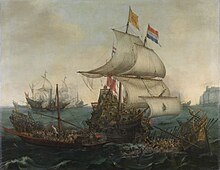
Dutch Ships Ramming Spanish Galleys off the Flemish Coast in October 1602, 1617, by Hendrick Vroom
Especially in Northern Europe, pocket-sized groups of soldiers became a pop subject for paintings and specially prints by many artists, including Urs Graf, who is unusual in that he was a professional Swiss mercenary for many years. These works began to present a less heroic view of soldiers, who oft represented a considerable threat to civilian populations even in peacetime, though the extravagant costumes of the Landsknecht are often treated as glamorous.[eleven] For Peter Paret, from the Renaissance "the glorification of the temporal leader and of his political system - which had of course too been nowadays in medieval art - replaces the Christian religion as a determining interpretive force" in military art.[12]
Naval painting became conventionalized in 17th century Dutch Gilded Age painting, and from and so on artists tended to specialize in information technology or not attempt it; apart from anything else "Marine artists have ever dealt with a peculiarly enervating course of patron", as JMW Turner establish when the "Sailor Rex" William IV of the Great britain rejected his version of The Battle of Trafalgar because of inaccuracy. Hendrick Vroom was the earliest real specialist, followed by the father and son team of Willem van de Velde, who emigrated to London in 1673, and finer founded the English tradition of naval painting, "producing a stunning visual record of the Anglo-Dutch naval wars, which set the conventions of maritime battle painting for the next 150 years". Vroom had too worked for English language patrons, designing a large set of tapestries of the defeat of the Spanish Armada which was destroyed when the Houses of Parliament burnt downward in 1834.[thirteen]
The 17th and 18th centuries saw depictions of battles mostly adopting a bird'southward eye view, as though from a hill nearby; this fabricated them less interesting to paint, and the major artists at present tended to avoid them. A very different view of warfare is seen in Les Grandes Misères de la guerre ("The Misfortunes of War"), a prepare of twelve etchings produced past Jacques Callot during the 30 Years War which follows a group of soldiers ravaging the countryside before eventually being rounded up by their own side and executed.[14] Also in the first half of the 17th century, a branch of genre painting in Dutch Golden Age painting specialized in guardroom scenes of rather hell-raising soldiers, not often in battle, but ransacking farmhouses or sitting around in a camp guardroom.[fifteen] The paintings of Salvator Rosa, essentially landscapes, oft showed groups variously described as bandits or soldiers lurking in the countryside of Southern Italian republic. The Surrender of Breda by Velázquez (1634–35) shows a crowded scene as the two sides come across peacefully to surrender the town; a theme more often copied in naval painting than land-based war machine art.[6]

From at least the late 15th century, sets of tapestries became the grandest medium for "official military art"; the Portuguese Pastrana Tapestries (1470s) were an early example. A set produced for the Duke of Marlborough showing his victories was varied for different clients, and even sold to i of his opponents, Maximilian Two Emanuel, Elector of Bavaria, later reworking the general'south faces and other details.[16] [17]
In the mid-18th century, a number of artists, especially in Britain, sought to revive armed forces art with large works centred on a heroic incident that would once again bring the genre to the fore in history painting, as it had been in the Renaissance. The standard contemporary battle scene tended to be grouped in the lowly category of topographical painting, covering maps and views of country houses. The Death of General Wolfe (1771) by Benjamin West, The Decease of Helm James Cook (1779) past Johann Zoffany, The Defeat of the Floating Batteries at Gibraltar, September 1782 and The Expiry of Major Pierson (1784) past John Singleton Copley are leading examples of the new type, which ignored complaints about the unsuitability of modern wearing apparel for heroic subjects. Nonetheless such works had more than immediate influence in France than in Britain.[18]
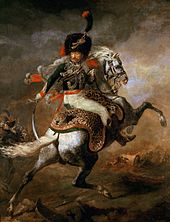
In the Napoleonic era, France added Romanticism to its style and began to portray individual soldiers with more character. Battle paintings were increasingly produced for large public buildings, and grew larger than always before. Businesswoman Gros painted more often than not glorifications of Napoleon and his victories, but his 1808 painting of the Battle of Eylau does not neglect the suffering of the expressionless and wounded on the frozen battlefield.[19] In dissimilarity, Goya'southward large paintings The 2nd of May 1808 and The Third of May 1808, maybe consciously conceived as a riposte to Gros, and his related serial of 82 etchings, The Disasters of War (Spanish: Los Desastres de la Guerra), emphasized the brutality of the French forces during the Peninsular War in Kingdom of spain.[20] [21] British depictions of the Napoleonic Wars continued the tardily 18th century patterns, often on a larger scale, with the death of Admiral Horatio Nelson quickly producing large works past Arthur William Devis (The Death of Nelson, 21 October 1805) and West (The Decease of Nelson). J. Thou. Due west. Turner was amidst the artists who produced scenes of Nelson's victories, with The Battle of Trafalgar.[22] The British Institution ran competitions for sketches of art commemorating British victories, the winning entries being then deputed.[23]

tenth Regiment of Hussars, by Carle Vernet
In this period the uniform print, concentrating on a detailed delineation of the compatible of one or more than continuing figures, typically hand-coloured, also became very popular across Europe. Similar other prints these were typically published in book form, but also sold individually. In Britain the 87 prints of The Loyal Volunteers of London (1797–98) by Thomas Rowlandson, published by Rudolph Ackermann, mark the showtime of the archetype menstruation. Though Rowlandson normally satirized his subjects to some degree, hither the soldiers were "represented as they, and especially their colonels who paid for their uniforms, preferred to meet themselves", which remained the usual depiction in such prints.[24] A fix of prints by Carle Vernet of the splendid uniforms of La Grande Armée de 1812 showed most foot-soldiers in pairs in campsite, in a variety of relaxed poses that showed one from the front and the other from backside. A rare oil painting by a leading artist that treats soldiers in the spirit of the uniform impress is Soldiers of the 10th Light Dragoons (the "Prince of Wales Own") painted in 1793 by George Stubbs for their Colonel in Chief, the time to come George IV of the U.k.. Other paintings of single soldiers were more dramatic, like Théodore Géricault's The Charging Chasseur (c. 1812).
Nineteenth century [edit]

Eugène Delacroix, who also painted many smaller combat scenes, finished his The Massacre at Chios in 1824, showing a then notorious attack on Greek civilians by Ottoman forces during the Greek War of Independence, who are shown in an entirely negative light. Information technology had a more than firsthand impact on European art than Goya's Tres de Mayo (The Third of May 1808) of a few years earlier, which was evidently not even on display in the Prado Museum until some years subsequently. In contrast, Delacroix's Liberty Leading the People of 1830 showed fighting in a positive light, but not the "military" as it shows armed civilian revolutionaries of the July Revolution, advancing against the unseen uniformed forces of the government.[25] Turkish atrocities were to remain a recurrent theme in 19th-century painting, particularly in old Ottoman territories escaped from the failing empire (oftentimes pre-rape scenes treated rather salaciously), and general anti-military sentiments, previously mostly plant in prints, were also to emerge regularly in big oil paintings.
Military fine art remained popular during the remainder of the 19th century in most of Europe. French artists such as Ernest Meissonier,[26] Edouard Detaille,[27] and Alphonse de Neuville[28] established war machine genre painting in the Paris Salon.[29] New forms of military art which developed in the 1850s met considerable opposition from the Royal University in the Great britain.[30]
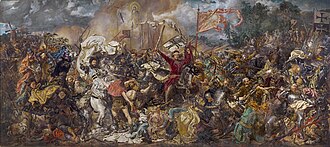
European artists in a generally academic fashion who were well known as painters of battle scenes, even so ofttimes of subjects from the Napoleonic Wars or older conflicts, included Albrecht Adam,[31] Nicaise de Keyser,[32] Piotr Michałowski[33] Antoine Charles Horace Vernet,[34] Emile Jean Horace Vernet,[35] Wilhelm Camphausen and Emil Hünten. The ascent of nationalism promoted battle painting in countries such as Hungary (great attending paid to uniforms), Poland (huge forces) and the Czech Lands. Jan Matejko'due south enormous Battle of Grunwald (1878) reflects Pan-Slav sentiment, showing various Slav forces joining together to smash the power of the Teutonic Knights.
The usage of the term "armed services art" has evolved since the middle of the 19th century. In France, Charles Baudelaire discussed military fine art, and the touch on on it of photography, in the Paris Salon of 1859.[36] A British critic of the Royal Academy exhibition of 1861 observed that
British painters have never fully grappled with military fine art, they have only hovered around the edges, touching and trimming. -- William Michael Rossetti[37]

In contrast, the British artist Elizabeth Thompson (Lady Butler) explained that she "never painted for the glory of state of war, just to portray its pathos and heroism."[38] The backwash of battle was depicted in paintings like Calling the Roll After An Engagement, Crimea, which displayed at the Royal Academy in 1874. This perspective is besides seen in Remnants of an Ground forces which showed William Brydon struggling into Jalalabad on a dying horse. Dr. Brydon was the sole survivor of the 1842 retreat from Kabul, in which 16,000 were massacred by Afghan tribesmen.[39]

The British market began to develop in the middle of the 19th century.[40] The relations between the state and its military machine, and the ideologies which are unsaid in that relationship afflicted the artwork, the artists and the public perceptions of both artwork and artists.[41]
Past the time of the American Ceremonious State of war and the Crimean War photographers began to compete strongly with artists in coverage of scenes in military camp, and the aftermath of battle, but exposure times were generally too long to enable them to take pictures of battles very effectively. War photography is not covered in this article. Illustrations for newspapers and magazines connected a heroic fashion with mayhap more confidence than painters, and Melton Prior followed British forces around Royal troublespots for decades, working for the Illustrated London News; his scenes "helped to establish a style of action draughtsmanship which has left an enduring stamp on the art of the comic strip."[42] Prior and other "special correspondents" such equally Frederic Villiers were known as "specials". Richard Caton Woodville Jr. and Charles Edwin Fripp were "specials" and also painters who exhibited at the Royal Academy and elsewhere.[42]
Twentieth century [edit]
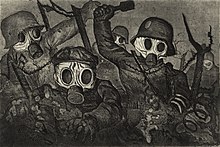
World War I very largely confirmed the finish of the glorification of state of war in art, which had been in decline since the end of the previous century.[43] In general, and despite the institution of large schemes employing official war artists, the near striking fine art depicting the war is that emphasizing its horror. Official war artists were appointed by governments for information or propaganda purposes and to record events on the battlefield;[44] but many artists fought every bit normal soldiers and recorded their experiences at the time and afterwards, including the Germans George Grosz and Otto Dix, who had both fought on the Western Front, and continued to depict the subject for the residuum of their careers. Dix'due south The Trench (1923), showing the dismembered bodies of the dead later an assail, caused a scandal, and was first displayed backside a curtain, before causing the dismissal of the museum director who had planned to buy information technology. Later, after exhibiting information technology in their 1937 travelling exhibition of "Degenerate art", the Nazi government burnt it. He produced a set of fifty prints in 1924 on Der Krieg ("The War"). The English artist Paul Nash began to make drawings of the war while fighting on the Western Front in the Artists Rifles. After recovering from a wound he was recruited as an official state of war artist and produced many of the about memorable images from the British side of both World Wars. Later on the state of war, the huge need for state of war memorials caused a boom for sculptors, covered beneath, and makers of stained-glass.
Posters had become universal by 1914 and were addressed at both the war machine and the "home front" for diverse purposes, including recruitment, where the British Lord Kitchener Wants Y'all (not actually the slogan) was repeated in the Usa with Uncle Sam, and elsewhere with like totemic figures. The Soviet Union began with very Modernist posters such equally Beat the Whites with the Red Wedge by Lazar Markovich Lissitzky but presently turned to socialist realism, used for about Globe State of war II posters from the Soviet Marriage, which sometimes are similar to their Nazi equivalents. In World State of war II they were even more than widely used.[45] Illustrators and sketch artists such as Norman Rockwell also followed the tendency abroad from military themed shots following the Second Globe War and with the ascension of photographic covers in general.
The impact of the Spanish Civil War on a not-combatant populace was depicted in Picasso'southward masterpiece, Guernica, showing the bombing of Guernica in 1937;[46] a very unlike treatment of a similar subject is seen in Henry Moore's drawings of sleeping civilians sheltering from The Blitz bombing on the station platforms of the London Underground. Amongst official Globe War Two war artists, Paul Nash'due south Totes Meer is a powerful epitome of a scrapyard of shot-down German aircraft, and the landscapist Eric Ravilious produced some very fine paintings before being shot down and killed in 1942.[47] Edward Ardizzone's pictures concentrated entirely on soldiers relaxing or performing routine duties, and were praised by many soldiers: "He is the only person who has caught the atmosphere of this war" felt Douglas Cooper, the art critic and historian, friend of Picasso, then in a military medical unit.[48] Photography and film were now able to capture fast-moving action, and can adequately be said to take produced well-nigh of memorable images recording combat in the state of war, and certainly subsequent conflicts like the Vietnam War, which was more notable for specifically anti-state of war protestation art, in posters and the work of artists like Nancy Spero.[49] Contemporary military art is part of the subfield "military and popular culture".[50]
Art forms [edit]
Portraiture [edit]

Rulers have been shown in specifically war machine wearing apparel since ancient times; the difference is especially easy to see in Ancient Roman sculpture, where generals and increasingly often emperors are depicted with armour and the brusk armed forces tunic. Medieval tomb effigies more often than not depict knights, nobles and kings in armour, whether or not they saw agile service. In the Early Mod period, when senior commanders tended to wear their normal riding clothes even on the battlefield, the distinction between a military machine portrait and a normal one is more often than not conveyed by the background, or by a breastplate or the buff leather jerkin worn underneath armour, but in one case fifty-fifty generals began to wear armed services uniform, in the mid-18th century, it becomes clear again,[51] although initially officer's uniforms were shut to smart civilian costume.
Total-length and equestrian portraits of rulers and generals often showed them on the battlefield, but with the action in the afar groundwork; a feature probably dating back to Titian's magisterial Equestrian Portrait of Charles V, which shows the emperor after his victory at the Battle of Mühlberg merely with no other soldiers present. Monarchs were not often painted in military compatible until the Napoleonic period, but in the 19th century this became typical for formal portraits, perhaps considering uniform was more than visually highly-seasoned. A distinctively Dutch type of painting are huge group portraits commissioned by the wealthy role-time officers of city militia companies, of which Rembrandt's Night Watch is much the most famous, although its narrative setting is atypical of the genre. Almost examples just bear witness the officers lined up equally though almost to eat dinner, and some show them actually eating it.[52] Otherwise group portraits of officers are rather surprisingly rare until the 19th century.
Sculpture [edit]
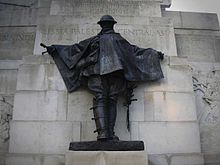
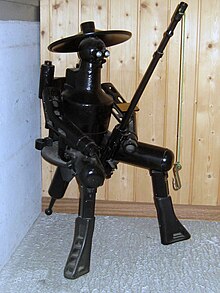
Sculpture made from Swiss set on rifles Stgw 57
Most surviving sculpture of battle scenes from antiquity is in stone reliefs, covered above. Renaissance artists and patrons were bully to revive this form, which they mostly did in much smaller scenes in stone or statuary. The tomb in Milan of the brilliant French general Gaston of Foix, Duke of Nemours included numerous marble reliefs round the base of the sarcophagus (which was never completed). Statues and tomb monuments of commanders continued to be the nigh common site until the more general state of war memorial commemorating all the dead began to sally in the period of the Napoleonic Wars. Nelson's Column in London yet commemorates a unmarried commander; it has very big reliefs around the base of operations by dissimilar artists, although these are mostly regarded equally less memorable than other aspects of the monument. Wellington's Column in Liverpool is also known as the "Waterloo Memorial", shifting to the more modern concept when "the expressionless were remembered essentially equally soldiers who fought in the name of national collectives".[53]
The huge losses of the American Ceremonious War saw the first really large grouping of sculptural war memorials, as well as many monuments for individuals. Among the about artistically outstanding is the Memorial to Robert Gould Shaw and the all-black 54th Regiment by Augustus Saint-Gaudens in Boston, with a 2d bandage in the National Gallery of Art, Washington. The even larger losses of Globe War I led fifty-fifty small communities in most nations involved to heighten some grade of memorial, introducing the widespread use of the grade to Commonwealth of australia, Canada and New Zealand, the sudden increase in need leading to a nail for sculptors of public art. Even more in painting, the war brought a crunch in way, every bit much public opinion felt the traditional heroic styles inappropriate. One of the near successful British memorials is the starkly realist Royal Arms Memorial in London, the masterpiece of Charles Sargeant Jagger, who had been wounded three times in the war and spent virtually of the next decade commemorating it. In the defeated nations of Germany and Austria controversy, which had a political aspect, was especially fierce, and a number of memorials considered excessively modern were removed by the Nazis, whose own memorials, such as the Tannenberg Memorial were removed after Earth War 2.[54] Other solutions were to brand memorials more neutral, as in the repurposed Neue Wache in Berlin, since rededicated to different groups several times, and the dignified architectural forms of the Cenotaph in London (widely imitated) and the German Laboe Naval Memorial; tombs of the Unknown Warrior and eternal flames were other means of avoiding controversy. Some, similar the Canadian National State of war Memorial, and well-nigh French memorials, were content to update traditional styles.[55]
A smashing number of World War I memorials were simply expanded in scope to embrace the dead of World War 2, and oftentimes subsequent conflicts. The now dominant role of photography in depicting state of war is reflected in the National Iwo Jima Memorial, which recreates the iconic photograph Raising the Flag on Iwo Jima. The National D-Day Memorial, a project of the 1990s, includes strongly realist sculpture, in contrast to the Vietnam Veterans Memorial in Washington. More innovative memorials accept often been erected for the civilian victims of war, higher up all those of the Holocaust.[56]
Scope [edit]
Peacetime [edit]

Rice distribution at Carrefour in Haiti subsequently the convulsion in 2010. Oil sketch by Sgt. Kristopher Battles, USMC
Military machine art encompasses actions of military forces in times of peace. For example, USMC Sgt. Kristopher Battles, the only remaining official American war artist in 2010, deployed with American forces in Haiti to provide humanitarian relief as part of Operation Unified Response after the disastrous convulsion in 2010.[57]
Wartime [edit]

Canadian Gunners in the Mud, Passchendaele by Lieutenant Alfred Bastien, 1917, oil on sheet. Bastien depicts a grouping of gunners struggling to release ane of their guns from the mud. The focus on the gun, rather than on the soldiers, underlines the importance of this weapon to success on the battlefield. -- Canadian War Museum
Purpose [edit]
War art creates a visual business relationship of military conflict by showing its impact equally men and women are shown waiting, preparing, fighting, suffering, and celebrating.[58] [59]The subjects encompass many aspects of war, and the individual'southward experience of war, whether allied or enemy, service or noncombatant, war machine or political, social or cultural. The thematic range embraces the causes, course and consequences of conflict.[60]
War art, a meaning expression of any civilisation and its significant legacies, combines artistic and documentary functions to provide a pictorial portrayal of state of war scenes and show "how war shapes lives."[60] [61] [62] [63] [64] It represents an attempt to come to terms with the nature and reality of violence.[65] War art is typically realistic, capturing factual, eyewitness particular also as the emotional impression and affect of events.[66] Fine art and war becomes "a tussle between the globe of the imagination and the world of action" — a abiding tension between the factual representation of events and an artist's interpretation of those events.[67]
Part of the tussle includes determining how best to illustrate complex war scenes. C.Eastward.W. Bean'south Anzac Book, for example, influenced Australian artists who grew up betwixt the two world wars. When they were asked to depict a 2nd multi-nation war after 1939, there was a precedent and format for them to follow.[68]
State of war art has been used as an instrument of propaganda, such as a nation-edifice function or other persuasive ends.[63] [69] [seventy] War art is also captured in caricature, which offers contemporary insights.[71] Western Civilization and aesthetic tradition were both clearly marked by military conflicts throughout history. War collection civilisation and culture drove war. The legacy of state of war inspired artworks reads like a serial of mile markers, documenting the meandering class of civilisation'southward evolutionary map.[72]
War artists [edit]
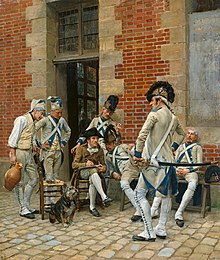
War artists may exist involved as onlookers to the scenes, war machine personnel who reply to powerful inner urges to depict straight war experience, or individuals who are officially commissioned to be present and record military activity.[73]
As an example of nation's efforts to document war events, official Japanese war artists were commissioned to create artwork in the context of a specific war for the Japanese government, including sensō sakusen kirokuga ("war campaign documentary painting"). Betwixt 1937 and 1945, approximately 200 pictures depicting Japan's military machine campaigns were created. These pictures were presented at large-scale exhibitions during the war years; After the end of World War 2, Americans took possession of Japanese artwork.[74] [75] [76]
There are some who may choose not to create war art. During the course of Globe War Ii, the Italians created nearly no fine art which documented the disharmonize. The French began to paint the war only after the state of war was ended in 1945.[77]
Classical examples [edit]
Examples of classical state of war art include the friezes of warriors at the Temple of Aphaia in Hellenic republic or the Bayeux Tapestry, is a linear panoramic narrative of the events surrounding the Norman Conquest and the Battle of Hastings in 1066.[ix] [78]
Gallery [edit]


The Room in the McLean Business firm, at Appomattox C.H., in which Gen. Lee surrendered to Gen. Grant, April 9, 1865. This lithograph of the result shows the two men as they waited for the peace terms to exist copied.
Officers shown here
Portraits, left to correct: John Gibbon, George Armstrong Custer, Cyrus B. Comstock, Orville E. Babcock, Charles Marshall, Walter H. Taylor, Robert E. Lee, Philip Sheridan, Ulysses Due south. Grant, John Aaron Rawlins, Charles Griffin, unidentified, George Meade, Ely Southward. Parker, James W. Forsyth, Wesley Merritt, Theodore Shelton Bowers, Edward Ord. The man not identified in the picture'southward fable is idea to exist General Joshua Chamberlain, who presided over the formal surrender of artillery by Lee's Army of Northern Virginia on April 12, 1865.

Marines lug their packs out to the waiting helo in Haiti in 2010. Sketch past Battles, USMC


"Great achievements of the Prc in the past 3 years" (334,053,057 people supporting a P5 peace treaty, mass donation worth iii,710+ fighters, 570,000+ enemy casualties including 250,000+ American invaders), a affiche in mainland China about the Korean War, circa 1950s
Cavalry [edit]
-
Bercheny's Hussars, French light cavalry, 1776.
-
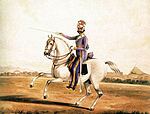
Portrait of a mounted Sowar of the sixth Madras Calorie-free Cavalry, circa 1845.
-

-

-

-

Offer a drink of water to a fallen soldier [edit]
-

Sketch showing American POWs in a Japanese prison army camp in the Philippines, 1945
River crossings [edit]
Propaganda [edit]
-

The Woman'south Country Army of America, US, 1918
-

Our boys demand sox - knit your bit, US, 1917-1918
-

Victory garden affiche, US, 1945
Come across also [edit]
- War artists
- American official war artists
- Australian official war artists
- British official war artists
- Canadian official war artists
- German language official war artists
- Japanese official state of war artists
- New Zealander official war artists
- Heraldry
- The Equus caballus in Fine art
- Militaria
- State of war photography
- War rugs, a contempo tradition of Afghanistan
Notes [edit]
- ^ "War art" in the Oxford Companion to Military History, on Answers.com, and the article by Richard Woodward on "Armed forces artists" in the same work (penultimate paragraph); annotation that the term does not appear at all in Grove Fine art Online, or other large art reference works. As formal "wars" have largely vanished, "gainsay creative person" seems to exist replacing "war artist" in official use.
- ^ Pepper, Introduction
- ^ Strudwick (2005), p. 371
- ^ Baker (2008), p. 84
- ^ Rawson, 103
- ^ a b c "Military Artists" in the Oxford Companion to Military History, on Answers.com
- ^ a b Pepper, ane (i)
- ^ Schapiro, 153
- ^ a b UNESCO Archived 2012-02-17 at the Wayback Machine, Bayeaux tapestry, Nomination Grade, p. 4; excerpt,"... information technology is an established fact that it recounts a military triumph: the conquest of England by William the Conqueror"; Nomination Form, pp. five-half dozen; extract, "This big-scale textile work of the 11th century is, to our noesis, the only one of its kind to have survived to the present twenty-four hour period. The Tapestry is an well-nigh contemporary visual tape of the event information technology depicts, one of the most significant events of Medieval times. Information technology tells of the beginnings of the Norman Conquest; the landing of Norman and French troops in England and the Battle of Hastings"
- ^ Hartt, 457 on Leonardo (quoted), 470-471 on Michelangelo, 246-248 on Uccello.
- ^ Pepper, one (iii), Kettering, 104
- ^ Paret, 13
- ^ Pepper, 3 (i) quoted on patrons; 2 (ii) quoted on van de Veldes; Slive, Chapter nine.
- ^ Becker, 155-156; "Military Artists" in the Oxford Companion to Military History, on Answers.com
- ^ Pepper, two (i); Kettering, 104-109
- ^ Pepper, 2 (i)
- ^ 1704 Battle of Blenheim depicted in tapestry at Blenheim Palace
- ^ Hichberger, ten-11
- ^ Norman, Geraldine. (1977). "Gros, Baron Antoine Jean", Nineteenth-century Painters and Painting: A Dictionary, p. 100., p. 100, at Google Books
- ^ Pepper, iii (two); Honour & Fleming, 483
- ^ Norman, "Goya y Lucientes, Franciso José de", p. 99., p. 99, at Google Books
- ^ Pepper, 3 (i)
- ^ Hichberger, 14-28
- ^ Russell, 73-74, quoting Ford'due south history of the Ackermann house.
- ^ Honour and Fleming, 487-488
- ^ Norman, "Messonier, Jean Louis Ernest", p. 145., p. 145, at Google Books
- ^ Norman, "Detaille, Jean Baptiste Edouard", p. 73., p. 73, at Google Books
- ^ Norman, "Neuville, Alphonse Marie de", p. 159., p. 159, at Google Books
- ^ Sullivan, A.Due east. (1958). "Military Fine art and Artists", Army Quarterly and Defense force Journal, Vol. 76-77, pp. 235-236; excerpt, "A collaborator of Detaille, and similar him a specialist in military art, was Alphonse de Neuville (1836–1885), who made his debut at the Salon in 1859 with a scene showing a French battery at Sebastapol."
- ^ Hichberger, pp. 58., p. 58, at Google Books
- ^ Norman, "Albrecht, Adam", p. 28., p. 28, at Google Books
- ^ Norman, "Keyser, Nicaise de", p. 120., p. 120, at Google Books
- ^ Norman, "Michalowski, Piotr", p. 120., p. 120, at Google Books
- ^ Norman, "Vernet, Antoine Charles Horace", p. 211., p. 211, at Google Books
- ^ Norman, "Vernet, Emile Jean Horace", p. 212., p. 212, at Google Books
- ^ Paret, Peter (1997). Imagined Battles. Reflections of War in European Art, p. 85., p. 85, at Google Books, citing Charles Baudelaire. (1992). "The Salon of 1859", Selected Writings on Fine art and Literature, trans. P. E. Charvet, pp. 295, 297; extract, "In a section preceding the discussion of armed services art in his articles on the Salon of 1859, Baudelaire discussed the advent of photography and its affect on art."
- ^ Hichberger, pp. 68-69., p. 68, at Google Books; the term war machine art is not a neologism
- ^ Mcintyre, Ben. September 10, 2009 "Pictures of war tin can carry more moral pregnant than thousands of words," The Times (London). September 10, 2009.
- ^ McIntyre, "Pictures," September 10, 2009; "The Disasters in Afghanistan," The Times. Apr seven, 1842.
- ^ Hichberger, p. 71., p. 71, at Google Books
- ^ Hichberger, p. 2-3., p. 2, at Google Books
- ^ a b Pepper, iii, (ii)
- ^ Pepper, Introduction and three, 2
- ^ National Archives (Great britain), "'The Art of State of war,' Learn About the Art."
- ^ James covers all major combatant nations of World War I; for British World War 2 posters, and a wider bibliography, see Weapons on the Wall in external links
- ^ Walker, William. The Lessons of Guernica," Archived 2010-12-04 at the Wayback Auto Toronto Star. February 9, 2003.
- ^ Brandon, 66
- ^ Foss, 123
- ^ Brandon, 77-83
- ^ Ender M.G., Reed B.J., Absalon J.P. (2020) Popular Civilization and the Military. In: Sookermany A. (eds) Handbook of Military Sciences. Springer, Cham. https://doi.org/x.1007/978-3-030-02866-4_36-1 https://link.springer.com/referenceworkentry/ten.1007/978-3-030-02866-4_36-1
- ^ Kettering, 100
- ^ Slive, 250-251
- ^ Carrier, 18
- ^ Mosse, 97–98
- ^ Mosse, 103–106 on conservatism, and more often than not throughout Chapter 5 on war memorials.
- ^ Carrier, throughout. His Chapter 1 gives an overview of the report of 19th and 20th century memorials
- ^ Kino, Ballad. "With Sketchpads and Guns, Semper Fi"; "Marine Art," New York Times. July xiii, 2010; Sketchpad Warrior blog, "It's All in the Wrist", May 25, 2010.
- ^ Canadian War Museum (CWM), "Australia, United kingdom of great britain and northern ireland and Canada in the Second World War," 2005.
- ^ Hichberger, J.West.Yard. (1991). Images of the Army: The Military machine in British Art, 1815–1914, pp. 12-xiii., p. 12, at Google Books; Brandon, Laura. (2008). Art and War, pp. 4-9., p. 4, at Google Books
- ^ a b Royal State of war Museum (IWM), About the Purple State of war Museum Archived 2010-12-05 at the Wayback Machine
- ^ Brandon, Laura. (2008). Art and War, p. 4., p. four, at Google Books
- ^ Foss, p. 131., p. 131, at Google Books
- ^ a b Foss, Brian. (2006). War Pigment: Art, War, State, and Identity in United kingdom, 1939-45, p. 157., p. 157, at Google Books; excerpt, "records that were as much artistic as documentary."
- ^ Maenius, Chase (2015). xiii Masterpieces. Underground Media. pp. 27–29. ISBN978-1320309554.
- ^ Foss, p. 124., p. 124, at Google Books
- ^ Foss, p. 134., p. 134, at Google Books
- ^ Gough, Paul. (2010) A Terrible Dazzler: British Artists in the Get-go Earth War, p. three.
- ^ Reid, John B. (1977). Australian Artists at State of war, Vol. 2, p. 5; excerpt, "The Australian people first became familiar with Australasian war art as a genre with the publication of the so-chosen 'Christmas books' ... which independent the writings of servicemen and were illustrated by the current state of war artists."
- ^ Brandon, p. 6., p. 6, at Google Books
- ^ Brandon, p. 58., p. 58, at Google Books
- ^ ASKB, Caricature
- ^ Chase Maenius. The Art of State of war[southward]: Paintings of Heroes, Horrors and History. 2014. ISBN 978-1320309554
- ^ Oxford Companion to Military History
- ^ McCloskey, Barbara. (2005). Artists of World War II, pp. 111-126.
- ^ Tsuruya, Mayu. "Cultural Significance of an Invisible Emperor in Sensô Sakusen Kirokuga ('War Campaign Documentary Painting')." Clan for Asian Studies (AAS), Annual Meeting (Boston, Massachusetts), March 22–25, 2007.
- ^ Nara, Hiroshi. (2007). Inexorable Modernity: Japan'southward Grappling with Modernity in the Arts, p. 97 n47., p. 97, at Google Books
- ^ Ross, Alan. (1983). Colours of State of war, p. 118.
- ^ Stover, Eric et al. (2004). My Neighbor, my Enemy, p. 271., p. 271, at Google Books
References [edit]
- Baker, Darrell (2008). The Encyclopedia of the Pharaohs: Volume I – Predynastic to the Twentieth Dynasty 3300–1069 BC. Stacey International. ISBN 978-1-905299-37-nine
- DP Becker in KL Spangeberg (ed), Half-dozen Centuries of Master Prints, Cincinnati Art Museum, 1993. ISBN 0-931537-15-0
- Brandon, Laura. (2008). Art and War. New York: I.B. Tauris. ISBN 978-ane-84511-237-0; OCLC 225345535
- Carrier, Peter. Holocaust monuments and national memory cultures in France and Federal republic of germany since 1989: the origins and political office of the Vél' d'Hiv' in Paris and the Holocaust Monument in Berlin, Berghahn Books, 2006, ISBN 1-84545-295-X, 9781845452957
- Foss, Brian. (2006). War Paint: Art, War, Land, and Identity in Britain, 1939-45. New Haven: Yale Academy Press. ISBN 978-0-300-10890-3; OCLC 166478725
- Gough, Paul. (2010). A Terrible Dazzler: British Artists in the Outset World War. Bristol: Sansom & Co. ISBN 9781906593001; OCLC 559763485
- Hartt, Frederick, History of Italian Renaissance Fine art, (2nd edn.)1987, Thames & Hudson (US Harry N Abrams), ISBN 0-500-23510-4
- Hichberger, J.W.M. (1991). Images of the Army: The Military in British Art, 1815–1914. Manchester: Manchester University Press. ISBN 978-0-7190-2675-ane; OCLC 232947212
- Holmes, Richard. (2003). The Oxford Companion to Military History. Oxford: Oxford University Press. ISBN 978-0-19-860696-3; OCLC 231975512
- Hugh Honour and John Fleming, A World History of Fine art, 1st edn. 1982 & many later editions, Macmillan, London, page refs to 1984 Macmillan 1st edn. paperback. ISBN 0-333-37185-2
- James, Pearl. Motion-picture show this: World State of war I posters and visual civilization, 2010, Academy of Nebraska Printing, ISBN 0-8032-2610-1, ISBN 978-0-8032-2610-4, [1]
- Kettering, Alison McNeal. Gerard ter Borch's Military Men; Masculinity Transformed, in The public and private in Dutch culture of the Golden Age, Arthur K. Wheelock, Adele F. Seeff (eds), 2000, University of Delaware Press, ISBN 0-87413-640-7, ISBN 978-0-87413-640-1
- Maenius, Chase. "thirteen Masterpieces". Cloak-and-dagger Media Publishing, 2015. ISBN 1320309550
- McCloskey, Barbara. (2005). Artists of World War Two. Westport: Greenwood Printing. ISBN 978-0-313-32153-v; OCLC 475496457
- Mosse, Fallen Soldiers: Reshaping the Memory of the World Wars. Oxford University Printing US, 1991. ISBN 0-xix-507139-5, ISBN 978-0-19-507139-9
- Nara, Hiroshi. (2007). Inexorable Modernity: Japan's Grappling with Modernity in the Arts.Lanham, Maryland: Lexington Books. ISBN 978-0-7391-1841-2; ISBN 978-0-7391-1842-nine; OCLC 238825589
- Norman, Geraldine. (1977). Nineteenth-Century Painters and Painting: a Dictionary. Berkeley: University of California Printing. ISBN 978-0-520-03328-3; OCLC 300187133
- Pepper, Simon. "Battle pictures and military scenes", in Grove Art Online (restricted access, refs to sections), accessed March 22, 2011
- Rawson, Jessica (ed). The British Museum Volume of Chinese Art, 2007 (2d edn), British Museum Press, ISBN 978-0-7141-2446-nine
- Paret, Peter (1997). Imagined Battles. Reflections of War in European Art. Chapel Loma: University of N Carolina. ISBN 978-0-8078-2356-9; OCLC 260076007
- Reid, John B. (1977). Australian Artists at War: Compiled from the Australian War Memorial Collection. Volume 1. 1885–1925; Vol. ii 1940–1970. Due south Melbourne, Victoria: Sun Books. ISBN 978-0-7251-0254-8; OCLC 4035199
- Ross, Alan. (1983). Colours of State of war: War Art, 1939-45. London: J. Cape. OCLC 122459647
- Russell, Ronald, Discovering Antique Prints, Osprey Publishing, 2001, ISBN 0-7478-0499-0, ISBN 978-0-7478-0499-4, [two]
- Schapiro, Meyer, The Religious Meaning of the Ruthwell Cross (orig. 1944), in Selected Papers, volume 3, Late Antiquarian, Early Christian and Mediaeval Fine art, 1980, Chatto & Windus, London, ISBN 0-7011-2514-4
- Slive, Seymour Slive. Dutch Painting, 1600–1800, Yale Upward, 1995,ISBN 0-300-07451-4
- Stover, Eric and Harvey One thousand. Weinstein. (2004). My Neighbor, my Enemy: Justice and Community in the Aftermath of Mass Atrocity. Cambridge: Cambridge University Press. ISBN 978-0-521-83495-7; ISBN 978-0-521-54264-7; OCLC 183926798
- Strudwick, Nigel C. (2005). Texts from the Pyramid Age. Writings from the Ancient World (book xvi). Atlanta: Order of Biblical Literature. ISBN 978-1-58983-680-8
- Tsuruya, Mayu. (2005). Sensô Sakusen Kirokuga ("War Campaign Documentary Painting"): Japan'southward National Imagery of the 'Holy State of war', 1937-1945. Ph.D. dissertation, Academy of Pittsburgh.
Further reading [edit]
- Binek, Lynn K. and Walter A Van Horn. (1989). Cartoon the Lines of Boxing : Military Art of World War II Alaska. Anchorage, Alaska: Anchorage Museum of History and Art. OCLC 20830388
- Carman, W. Y. (2003). The Ackermann military prints: uniforms of the British and Indian armies, 1840–1855. Atglen, Pennsylvania: Schiffer Pub. ISBN 0-7643-1671-0
- Cork, Richard. 1994. A Biting Truth: Avant-garde Art and the Great War. New Haven: Yale Academy Printing. ISBN 978-0-300-05704-i; OCLC 185692286
- Foot, Michael Richard Daniel. (1990). Art and state of war: twentieth century warfare as depicted past war artists. London: Headline. ISBN 978-0-7472-0286-8; OCLC 21407670
- Gilkey, Gordon. State of war Art of the 3rd Reich. Bennington, Vermont: International Graphics Corporation, 1982. ten-I
- Gallatin, Albert Eugene. (1919). Fine art and the Great War. New York: E.P. Dutton. OCLC 422817
- Hale, John (1990). Artists and Warfare in the Renaissance. New Haven: Yale University Press. ISBN 0-300-04840-8.
- Hodgson, Pat (1977). The War Illustrators. London: Osprey. OCLC 462210052
- Johnson, Peter (1978). Front-Line Artists. London: Cassell. ISBN 978-0-304-30011-two; OCLC 4412441
- Jones, James (1975). WW 2: a Chronicle of Soldiering. New York: Grosset & Dunlap. 1617592
- Lanker, Brian and Nicole Newnham. (2000). They Drew Burn down: combat artists of World War II. New York: Television receiver Books. ISBN 978-one-57500-085-v; OCLC 43245885
- Hunt Maenius. The Art of War[southward]: Paintings of Heroes, Horrors and History. 2014. ISBN 978-1320309554
- Nevill, Ralph and William Gladstone Menzies. (1909). British Armed services Prints. London: The Connoisseur Publishing. OCLC 3509075
- Prendergast, Christopher (1997). Napoleon and history painting: Antoine-Jean Gros'due south La Bataille d'Eylau. Oxford: Oxford University Printing. ISBN 978-0-19-817402-8; ISBN 978-0-19-817422-vi; OCLC 35777393
- Australia
- Reid, John B. (1977). Australian Artists at War: Compiled from the Australian War Memorial Collection. Volume 1. 1885–1925; Vol. ii 1940–1970. South Melbourne, Victoria: Sunday Books. ISBN 978-0-7251-0254-8; OCLC 4035199
- Canada
- Brandon, Laura (2021). War Art in Canada: A Critical History. Toronto: Fine art Canada Institute, 2021. ISBN 978-1-4871-0271-5
- Oliver, Dean Frederick, and Laura Brandon (2000). Canvas of War: Painting the Canadian Experience, 1914 to 1945. Vancouver: Douglas & McIntyre. ISBN 978-1-55054-772-6; OCLC 43283109
- Tippett, Maria. (1984). Art at the Service of War: Canada, Art, and the Great War. Toronto: University of Toronto Press. ISBN 978-0-8020-2541-8; OCLC 13858984
- Germany
- Gilkey, Gordon. War Art of the Third Reich. Bennington, Vermont: International Graphics Corporation, 1982. ISBN 978-0-86556-018-5; OCLC 223704492
- Weber, John Paul. (1979). The German War Artists. Columbia, South Carolina: Cerberus. ISBN 978-0-933590-00-vii; OCLC 5727293
- Yenne, William P. (1983). High german State of war Art, 1939-1945. New York: Crescent Books. ISBN 978-0-517-34846-eight; OCLC 611620194
- Japan
- Nussbaum, Louis Frédéric and Käthe Roth. (2005). Japan Encyclopedia. Cambridge: Harvard Academy Press. ISBN 978-0-674-01753-5; OCLC 48943301
- Okamoto, Shumpei and Donald Keene. (1983). Impressions of the Front: Woodcuts of the Sino Japanese State of war, 1894-95. Philadelphia: Philadelphia Museum of Art. OCLC 179964815
- New Zealand
- Haworth, Jennifer. (2007). The Art of War: New Zealand War Artists in the Field 1939-1945. Christchurch, New Zealand: Take a chance Press. ISBN 978-one-877393-24-ii; OCLC 174078159
- Southward Africa
- Carter, Albert Charles Robinson. (1900). The Work of War Artists in Due south Africa. London: "The Art Periodical" Office. OCLC 25938498
- Huntingford, North. P. C. (1986). A Selection of South African Military art, 1939–1945, 1975–1985. Pretoria : Military Fine art Advisory Board, Defense Headquarters. OCLC 79317946
- Ukraine
- Еволюція воєнного мистецтва: у ii ч. / Д. В. Вєдєнєєв, О. А. Гавриленко, С. О. Кубіцький та ін.; за заг. ред. В. В. Остроухова. – К.: Вид-во НА СБУ, 2017.
- United Kingdom
- Gough, Paul. (2010). A Terrible Beauty: British Artists in the First World State of war. Bristol: Sansom and Company. ISBN 978-1-906593-00-1; OCLC 559763485
- Harries, Meirion and Suzie Harries. (1983). The State of war Artists: British Official War Art of the Twentieth Century. London: Michael Joseph. ISBN 978-0-7181-2314-7; OCLC 9888782
- Harrington, Peter. (1983). British Artists and War: The Face up of Battle in Paintings and Prints, 1700–1914. London: Greenhill. ISBN 978-1-85367-157-nine; OCLC 28708501
- Haycock, David Boyd. (2009). A Crisis of Brilliance: V Immature British Artists and the Great War. London: Old Street Publishing. ISBN 978-1-905847-84-half dozen; OCLC 318876179
- Sillars, Stuart (1987). Fine art and Survival in Commencement World State of war United kingdom of great britain and northern ireland. New York: St. Martins Press. ISBN 978-0-312-00544-3; OCLC 14932245
- Holme, Charles. (1918). The war depicted by distinguished British artists. London: The Studio. OCLC 5081170
- Thorniley-Walker, Jane. (2006). War Art: Murals and Graffiti - Military Life, Power and Subversion. Bootham: Council for British archaeology. ISBN 978-ane-902771-56-4; OCLC 238785409
- United states of america
- Cornebise, Alfred. (1991). Art from the trenches: America'south Uniformed Artists in World State of war I. College Station: Texas A & Thou Academy Press. ISBN 978-0-89096-349-4; OCLC 22892632
- Dempsey, Fifty James. (2007). Blackfoot War Art: Pictographs of the Reservation Catamenia, 1880-2000. Normanm Oklahoma: University of Oklahoma Press. ISBN 978-0-8061-3804-6; OCLC 70839712
- Foley, William A. (2003). Visions from a Foxhole: a rifleman in Patton'due south Ghost Corps. NY: Ballantine ISBN 9780891418122 plus Artist Interview about experience and exhibit at the Pritzker Military Library from January 22-April 9, 2010
- Gilkey, Gordon. War Art of the Third Reich. Bennington, Vermont: International Graphics Corporation, 1982). 10-I
- Harrington, Peter, and Frederic A. Sharf. (1988). A Excellent Fiddling War; The Spanish–American War, 1898; The Artists' Perspective. London: Greenhill. ISBN 978-1-85367-316-0; OCLC 260112479
External links [edit]
| | Wikimedia Commons has media related to War in art. |
- Army fine art of World War I. U.s. Army Centre of Military History : Smithsonian Establishment, National Museum of American History. 1993. Prints available online through the Washington State Library'due south Classics in Washington History drove
- War Art, 1500 New Zealand art works online
- Mémorial de Caen, 1914-1918 war, Artists of the First World War
- Ministry of Defence (Modern), Mod fine art collection, war artists
- National Athenaeum (Great britain), The Art of War
- Aviation and Military art at Curlie
- Anne S. One thousand. Brown Armed forces Collection, Brownish University Library
- Weapons on the Wall, British World War II posters
- Archives New Zealand, War Art digitization
Source: https://en.wikipedia.org/wiki/Military_art

